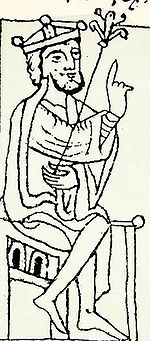| Ramiro I of Aragon | |
|---|---|

| |
| 13th century miniature of Ramiro | |
| Personal details | |
| Born | before 1007 |
| Died | 8 May 1063 Graus |
| Spouse(s) | Ermesinda of Bigorre Agnes |

The signum regis of Ramiro.
Ramiro I (bef. 1007 – 8 May 1063) was de facto the first King of Aragon from 1035 until his death. Apparently born before 1007, he was the illegitimate son of Sancho III of Navarre by his mistress Sancha de Aybar.[1] Ramiro was reputed to have been adopted by his father's wife Mayor after he was the only of his father's children to come to her aid when needed, although there is no surviving record of these events and the story is probably apocryphal.
During his father's reign, he appeared as witness of royal charters starting in 1011, and was given numerous properties in the county of Aragon, and by the division of Sancho's realm on the latter's death in 1035, the county of Aragon fell to Ramiro with the title of baiulus or steward. This was part of what would prove to be a larger division: Navarre and the Basque country went to eldest half-brother García, the county of Castile, already held by Ferdinand, reverted to its feudal fealty to the Kingdom of León, while the counties of Sobrarbe and Ribagorza fell to Gonzalo and Ramiro received lands in Aragon to hold under García.
Ramiro's exact status is vague. He was called king by his vassals, neighbors, the church and even his sons, yet he always referred to himself simply as Ranimiro Sancioni regis filio (Ramiro, son of King Sancho). Likewise, in his two wills, he refers to his lands as having been given him in stewardship: in the first by García, and in the second by God. He is called regulus (rather than rex used for García) and quasi pro rege (acting as if king) in charters from Navarre.[2] Due to his growing independence and the small size of his Pyrenean holdings, he is sometimes called a "petty king", Aragon a "pocket kingdom".
Ramiro sought to enlarge his lands at the expense of both the Moors and his brother, García, the King of Navarre. Shortly after the death of his father (the date variously placed from 1036 to 1043), he supported the emir of Tudela in an invasion of the Navarre. While he was defeated in the Battle of Tafalla, he still was able to gain territory, including Sanguesa, and established a state of semi-autonomy. In 1043, apparently with the approval of García, he annexed Sobrarbe and Ribagorza, previously held by his youngest legitimate half-brother, Gonzalo.[3] This union created a pseudo-independent Aragonese state, with its capital at Jaca, that would give rise to the Kingdom of Aragon.[4]
Before he was married, Ramiro had a mistress named Amuña with whom he had a natural son, Sancho Ramírez, in whom he confided the government of the county of Ribagorza.[5]
Ramiro wed his first wife, Gisberga, daughter of Bernard Roger of Bigorre, on 22 August 1036.[6] She changed her name to Ermesinda on marrying him. Together the couple had five children: Sancho Ramírez, his successor; García, Bishop of Jaca; Sancha, married Armengol III of Urgel; Urraca, nun in Santa Cruz de la Serós; and Theresa, married William Bertrand of Provence.
Ramiro's second wife was Agnes (Inés), was perhaps a daughter of the Duke of Aquitaine. After annexation of Ribagorza and Sobrarbe, Ramiro began the advance from Aragon toward Huesca and Zaragossa. The first charter for the royal town of Jaca is attributed to him. It included well defined laws of protection even to non residents, and would set an example for urban rights until late in the Middle Ages.
Ramiro died at the Battle of Graus in 1063 while trying to take the city.[7]
Sources[]
| Wikimedia Commons has media related to Ramiro I of Aragon. |
- Ballesteros y Beretta, Antonio. Historia de España y su Influencia en la Historia Universal. Barcelona: Salvat, 1920.
- Chaytor, H. J. A History of Aragon and Catalonia. London: Methuen, 1933.
- Lourie, Elena. "The Will of Alfonso I, 'El Batallador,' King of Aragon and Navarre: A Reassessment." Speculum, Vol. 50, No. 4. (Oct., 1975), pp 635–651.
- Nelson, Lynn. The Aragonese Acquisition of Sobrarbe and Ribagorza. Estudios en Homenaje a Don Claudio Sánchez Albornoz en sus 90 Años, 2:227-236 (1982).
- Ubieto Arteta, Antonio. "Estudios en torno a la división del Reino por Sancho el Mayor de Navarra", Príncipe de Viana, vol. 21, pp. 5–56, 163–236.
Notes[]
- ↑ The Crónica de Aragón, produced in 1499, names her Doña Caya, but she is named Sancha in a contemporary donation. Ballesteros y Beretta, v. 2, pp. 319–320.
- ↑ Ubieto Arteta, pp. 175–178; Nelson, pp. 228-229.
- ↑ Ubieto Arteta, pp. 169–173
- ↑ http://www.caiaragon.com/en/arbol/index.asp?idNodo=50&idNodoP=21
- ↑ Count Sancho Ramírez had a son, García, lord of Aybar and Atarés who in turn was father of Pedro de Atarés, lord of Borja, the initial candidate of the Navarre noblemen to succeed Alfonso the Battler. An origin legend of the house of Ayala gives Ramiro I another illegitimate son, Velasgutto de Ayala, by a Barcelona lady. However, this story is without solid foundation, and earlier versions of the legend make this Ayala founder, Vela, son of Ramiro's successor, Sancho Ramírez. Both may be confused memories of a feudal relationship of the early Ayalas with Sancho Ramírez of Viguera.
- ↑ Bernard F. Reilly, The Contest of Christian and Muslim Spain 1031-1157, (Blackwell Publishers Inc., 1995), 71.
- ↑ Richard Fletcher, The Quest for El Cid, (Oxford University Press, 1989), 113.
The original article can be found at Ramiro I of Aragon and the edit history here.